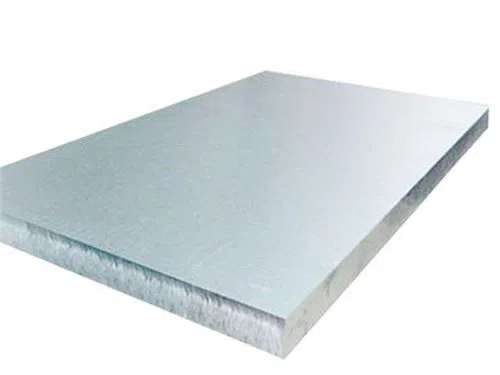Aluminum plate has a host of tremendous benefits that make it a popular choice among manufacturers. Whether you are drawn to it for the tremendous strength-to-weight ratio, excellent corrosion resistance or well-recognized aesthetic qualities, aluminum offers you the ability to produce competitive products at an affordable cost. Additionally, your customers will be happy with aluminum's durability and recyclability, meaning that it lasts longer and has less environmental impact when its life cycle does reach its end.
To get the most out of your aluminum products, some basic technical knowledge is helpful when you selecting an aluminum alloy for your application. Even alloys that on the surface appear quite similar can behave very differently in manufacturing processes. It’s important to do your homework before selecting an alloy and it's recommended you work with experts who can help you in your decision-making process if you are not familiar with aluminum products.

Today we're going to compare two of the most popular aluminum plate alloys currently on the market: 6061 and 7075.
WHAT ARE SOME COMMON USES FOR ALUMINUM PLATE?
Aluminum plate is technically a flat-rolled rectangular piece of aluminum thicker than a quarter of an inch. The process for creating aluminum plate involves flattening aluminum ingots with large rollers. These ingots can be as much as 6 feet wide and 20 feet long and weigh more than 20 tons. The ingots are preheated and then rolled back and forth until the desired flatness and thickness has been achieved. If desired, the aluminum will then be cold rolled or heat-treated to increase the strength.
If the resulting aluminum is less than a quarter of an inch thick then it is considered sheet; anything less than .2 millimeters is known as foil.
Aluminum plate is a very common product choice for working with this versatile metal. Some examples of industries that rely on aluminum plate include aerospace, defense and transportation. In aerospace applications the metal is used to form the skins of various critical parts, such as fuel tanks, jets, wings and fuselage. It can also be used for storage tanks in all kinds of industries, including the petrochemical and pharmaceutical fields. Other use cases include railcars, ships, military vehicles, tractor trailers and even some specialty uses like lithography.

WHAT ARE THE BENEFITS OF 6061 ALUMINUM PLATE?
6061 aluminum plate is one of the most versatile of all aluminum alloys, which is also why it's one of the most popular. Plate made from 6061 aluminum can be found in a whole range of applications, especially those that have multiple use scenarios where adaptability is a necessity.
The main alloying agents in 6061 aluminum plate are silicon and magnesium. After the rolling process, the plate will typically be strengthened through a process of precipitation hardening, which is what gives this material its superior structural strength and toughness. Precipitation hardening is a heat treatment technique that helps improve the properties of malleable materials such as aluminum.
6061 aluminum plate is able to maintain a good surface finish and features excellent corrosion resistance, even when exposed to atmosphere or seawater. Other benefits include its good machinability and weldability. It should be noted that when 6061 is welded it may lose some of its strength, so further heat treatment might be required.
Typical properties for 6061 aluminum plate include a tensile strength of 45,000 psi, with a yield strength of 40,000 psi. Its Brinell hardness is 95, with an elongation at break of 12% and shear strength of 31,000 psi. The thermal conductivity is 170 W/m-K and strength to weight ratio is 115 kN-m/kg.
Specific uses of 6061 aluminum plate include tooling, architecture, transportation, bridge railing, frames and running boards, platforms, flooring, steps, walkways, cover plates, bicycle frames, SCUBA tanks, fishing reels and small utility boats.
WHAT ARE THE BENEFITS OF 7075 ALUMINUM PLATE?
While less versatile than 6061, 7075 aluminum plate does offer many specific benefits that can be preferable for the right applications. The main difference is that 7075 is stronger. It offers upgrades both in terms of overall strength and strength-to-weight ratio compared with 6061. Other benefits include resistance to stress-corrosion cracking, good fatigue strength and decent machinability.
The main alloying agent of this aluminum is zinc. Its properties include a tensile strength of 83,000 psi, yield strength of 74,000 psi, Brinell hardness rated at 150, and an elongation at break of 10%. Its shear strength is 48,000 psi, with a thermal conductivity of 130 W/m-K and a strength to weight ratio of 196 kN-m/kg.
Potential drawbacks include less corrosion resistance than other alloys, poor weldability and cost. 7075 is more expensive than 6061, and thus is mainly used when its improved strength is a necessity. It also offers excellent hardness that allows it to handle a great deal of friction.
Because of its cost, 7075 plate is most commonly found in premium applications in the aerospace, marine and transportation industries. Other examples include high-end bicycle components, molds, airframes, and military-grade rifle receivers.
6061 is extremely adaptable and can be found in many more industries, while 7075 is most commonly selected where strength is of the utmost importance.
YOUR TECHNICAL SERVICES PROVIDER
Knowing which aluminum alloy is best for an application isn't easy and may require a lot of trial and error unless you are familiar with this material. That's why successful manufacturers choose to partner with suppliers who can help guide them through the material selection process. The priority at HENAN HENRY is always to help our clients find the right material for the job. That's why we do more than just sell products. In fact, our salespeople take pride in helping our customers succeed.
To learn more about the differences between 6061 and 7075 aluminum alloys, get in touch with one of our friendly and knowledgeable representatives today.




QR Code
